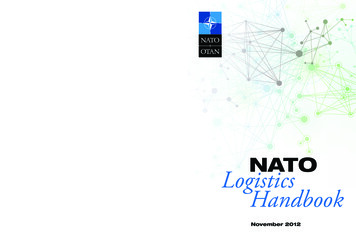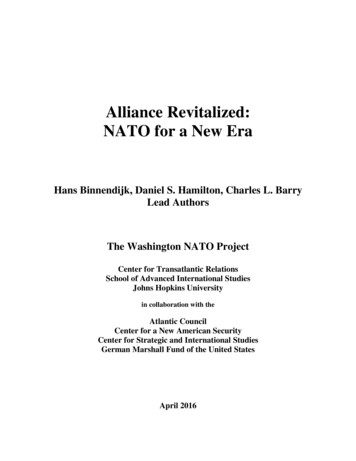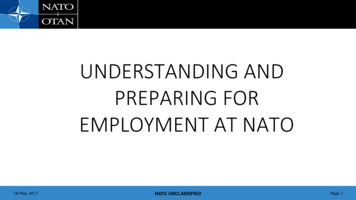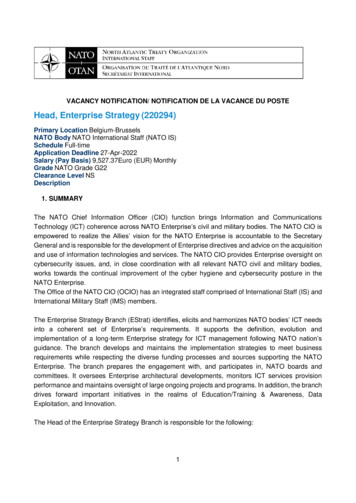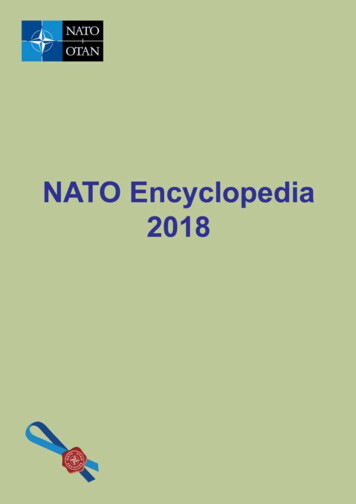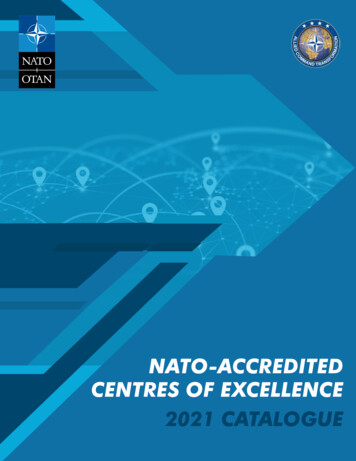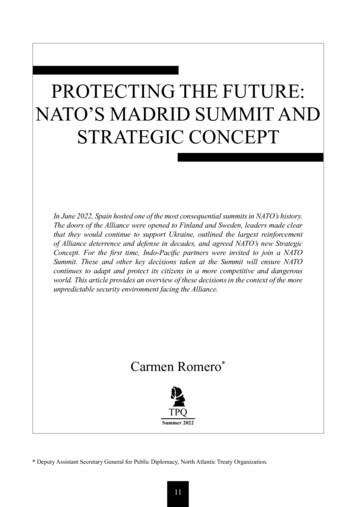
Transcription
PROTECTING THE FUTURE:NATO’S MADRID SUMMIT ANDSTRATEGIC CONCEPTIn June 2022, Spain hosted one of the most consequential summits in NATO’s history.The doors of the Alliance were opened to Finland and Sweden, leaders made clearthat they would continue to support Ukraine, outlined the largest reinforcementof Alliance deterrence and defense in decades, and agreed NATO’s new StrategicConcept. For the first time, Indo-Pacific partners were invited to join a NATOSummit. These and other key decisions taken at the Summit will ensure NATOcontinues to adapt and protect its citizens in a more competitive and dangerousworld. This article provides an overview of these decisions in the context of the moreunpredictable security environment facing the Alliance.Carmen Romero*TPQSummer 2022* Deputy Assistant Secretary General for Public Diplomacy, North Atlantic Treaty Organization.11
VOLUME 21 NUMBER 2CARMEN ROMEROIn June 2022, Spain hosted one of the most consequential summits inNATO’s history. The gathering of Allied leaders took place at a crucialmoment for our security, and the Allies proved up to the task. Theydemonstrated unity and resolve to confront current and future securitychallenges and threats, and opened the doors of the Alliance to two new invitees– Finland and Sweden – which will help enhance their security and strengthen theAlliance.The summit was particularly impactful for a range of reasons, not least becauseit took place against the backdrop of the Russian Federation’s brutal invasion ofUkraine. Russian aggression, in addition to creating unspeakable human sufferingand destruction in Ukraine, has increased global insecurity and instability, openlychallenging the mutually agreed principles that underpin European security andseriously undermining the rules-based international order. Leaders made clearthat NATO’s support to Ukraine will last for as long as it takes. By agreeing toa Comprehensive Assistance Package for Ukraine, Allies reaffirmed that theircommitment to Ukraine is unshakeable.During the Summit, Allies also adopted a new Strategic Concept, NATO’s roadmapfor the next decade. The Strategic Concept reaffirms NATO’s values, its purpose andits core tasks. It provides a collective assessment of the security challenges facingthe Alliance and outlines the political and military tasks NATO will carry out toaddress them.While NATO’s three core tasks– collective defense, crisis prevention andmanagement, and cooperative security– remain, this new Concept is significantlydifferent in scope and tone compared to its 2010 predecessor. Several aspects ofthe security environment a decade ago informed the 2010 Concept. The ambitionof that time was to develop a strategic partnership with the Russian Federation.There was also a belief that the international security order was, overall, morepredictable and that most security challenges would come from beyond NATO’sarea of responsibility. The People’s Republic of China (PRC) had not yet reachedthe transatlantic security agenda. These facts led to a consequent strong focus oncrisis management. As we enter the 2020s, the Madrid Concept describes today’smore unstable and challenging security environment, and makes clear the need forAllies to be prepared for this volatility.In light of this changed security environment, the recently adopted Madrid Conceptfocuses on the future trajectory of NATO-Russia relations, the strengthening ofNATO’s collective deterrence and defense posture, and on the framing of NATO’s12
PROTECTING THE FUTURE: NATO’S MADRID SUMMIT ANDSTRATEGIC CONCEPTrelationship with the PRC. It also makes pronounced reference to space, resilienceand cyber as integral elements of our collective deterrence and defense posture andcovers NATO’s evolving approach to a number of other threats and challenges,including terrorism and hybrid activities.In the Madrid concept, we also observe a stronger emphasis on collective defenseover crisis management and cooperative security. However, all three core taskspersist, recognizing that NATO is the only international organization that can mountand sustain complex, multinational operations; and because working with partnersremains key for NATO’s security and theirs, including through efforts aimed atenhancing their resilience.“NATO has undertaken the largest reinforcement of its deterrenceand defense since the end of the Cold War. In the wake of theRussian Federation’s war of aggression in Ukraine, the Alliancehas brought 40,000 multi-national troops under direct NATOcommand, in addition to the 100,000 U.S. troops deployed inEurope.”Together with the Strategic Concept, the decisions taken at the summit have setNATO’s strategic direction for the future, ensuring that the Alliance will continue toadapt to a changing world and keep its one billion people safe. Let us review thesedecisions in greater depth.NATO-Russia RelationsPerhaps the most notable difference between the Lisbon and the Madrid StrategicConcepts concerns the change in NATO’s relations with the Russian Federation. TheRussian Federation’s illegal annexation of Crimea in 2014, its aggressive patternof behavior against its neighbors and NATO Allies, and the full-fledged invasionof Ukraine in 2022 have broken the trust that was once at the core of the NATORussia relationship, changing it fundamentally for the long-term. In this context,meaningful dialogue with the Russian Federation is no longer possible, preciselybecause of its blatant violation of international law and use of military force againstan independent, sovereign nation.13
VOLUME 21 NUMBER 2CARMEN ROMEROThe new Strategic Concept reflects this reality and considers the Russian Federationthe most significant and direct threat to Allies’ security.1 NATO seeks stabilityand predictability in the Euro-Atlantic area and in NATO-Russia relations, butAllies have made it clear that any change in the relationship will depend on theRussian Federation putting an end to its aggressive behavior and complying withinternational law. Nevertheless, the Alliance will remain open to keeping channelsof communication with Moscow, in order to manage and mitigate risks, preventescalation, and increase transparency.This important shift is accompanied by concrete actions. NATO has undertaken thelargest reinforcement of its deterrence and defense since the end of the Cold War.In the wake of the Russian Federation’s war of aggression in Ukraine, the Alliancehas brought 40,000 multi-national troops under direct NATO command, in additionto the 100,000 U.S. troops deployed in Europe. NATO has doubled the number ofbattle groups along its eastern front, from the four established after the RussianFederation’s annexation of Crimea in 2014, to eight today.At the Madrid Summit, NATO Leaders agreed to further strengthen the Alliance’sdeterrence and forward defenses. This entails having more forces at higher readiness.The eight battlegroups on the eastern flank will be scaled up to brigade level. Therewill also be more pre-positioned equipment and weapons stockpiles, to allow NATOto be even more responsive in times of crisis or conflict. Allies also agreed a newforce model, which will strengthen and modernize the NATO Force Structure. Itwill also resource the Alliance’s new generation of military plans, in line with its360-degree approach, across the land, air, maritime, cyber and space domains andagainst all threats and challenges. Specifically, the new force model plans for over100,000 troops at ten day readiness, around 200,000 at 10 to 30 day readiness andat least 500,000 up to 30 to 180 day readiness. Forces will be earmarked to defendspecific, pre-assigned NATO countries, thereby ensuring security for the long term.The People’s Republic of China: Challenges and OpportunitiesIf we read the 2010 Strategic Concept through today’s geopolitical lens, we willnotice, perhaps with surprise, that it does not mention the PRC, as if the PRC has noimpact on the security of the Euro-Atlantic area. There is no denying that the rise ofthe PRC impacts our security: the PRC has the world’s second largest defense budgetand is investing heavily in modern military capabilities. It is substantially buildingup its military forces, including expanding its nuclear arsenal and developingincreasingly sophisticated delivery systems. At the same time, it is not party to any1NATO. “NATO 2022 Strategic Concept,” nato.int, https://www.nato.int/nato static ept.pdf14
PROTECTING THE FUTURE: NATO’S MADRID SUMMIT ANDSTRATEGIC CONCEPTexisting arms control treaties – crucial tools to increase transparency and reduce therisk of misunderstanding or miscalculation around these capabilities.The PRC is also increasingly assertive in the global arena and together with theRussian Federation, is using multilateral fora to push its autocratic agenda andundermine Western values and the rules-based international order. At the same time,the PRC continues to amplify the Russian Federation’s hostile information activitiesagainst NATO. The PRC’s investment in critical infrastructure in third countriesand indeed in NATO Allied nations, is a risk we must also be aware of. The use oftechnology and artificial intelligence to monitor and control its own citizens is alsoworrying. All of this has consequences for NATO’s security, interests and values.It is important to stress that the PRC is not NATO’s adversary and that is why wewill continue to look at both the challenges and the opportunities that it brings. Inthis context, while we take into account the consequences it presents to security, itis also important to have a dialogue with the PRC to discuss issues such as armscontrol or climate change.“At the NATO Summit, Allies reviewed the progress made inthe fight against terrorism and reconfirmed their commitment tocontinue this fight with determination and solidarity.”Our partners in the Asia-Pacific play a very important role here. NATO will continueto stand with its partners to preserve the rules-based international order, an orderbased on norms and values rather than on force. We are working together with themon cyber defense, emerging and disruptive technologies, maritime security, climatechange, and countering disinformation in order to help resist the PRC’s coercivepolicies.New – and Not So New – ChallengesWhile the Russian Federation’s invasion of Ukraine has brought militaryconfrontation back to Europe at a scale that we have not seen in many decades, thisis not the only threat that NATO faces. Cyber-attacks are becoming more frequentand sophisticated, terrorist threats persist, nuclear weapons are proliferating andclimate change is driving instability and fueling crises.15
VOLUME 21 NUMBER 2CARMEN ROMEROTaking into consideration these new security challenges, strengthening NATO’snational and collective resilience is a priority in the Madrid Strategic Concept. Eventhough the use of the term “resilience” in public discourse may be relatively new,NATO’s work on resilience is not. The concept is grounded in Article 3 of 1949’sNorth Atlantic Treaty. Our societies and our institutions must be able to better resistand bounce back from attacks. This includes many different elements to make oursocieties stronger: our infrastructure must be more resilient, we should diversify oursupply chains and make them more secure and of course, properly address hostileinformation activities seeking to divide us and weaken our democratic institutions.As NATO Secretary General Jens Stoltenberg has said on many occasions, civilianresilience is our first line of defense.Ensuring resilience also requires a robust technological base. For over 70 years,NATO has stayed at the forefront of technology development to ensure the defenseof its Allies and the success of its operations. Emerging and disruptive technologiesare also having a profound impact on security. These technologies are providingnew opportunities for NATO militaries, helping them become more effective,resilient, cost-efficient and sustainable. However, they also represent new threatsfrom state and non-state actors, both militarily and to society at large. To embracethese opportunities and at the same time counter these threats, NATO has recentlyestablished a Defence Innovation Accelerator for the North Atlantic (DIANA), tohelp develop cutting-edge solutions to security challenges by working closely withstart-ups, industry, and academia.Climate change is a defining challenge of our time, it acts as a crisis multiplierand more extreme weather devastates communities and fuels tensions and conflicts.Climate change matters for our security and we are working to incorporate it intoeverything we do – from defense planning to capability development and exercises.This calls for a fundamental transformation of NATO’s approach to defense andsecurity and sets NATO as the leading international organization in understandingand adapting to the security implications of climate change. In Madrid, Allies agreedto cut emissions by NATO bodies and commands by at least 45 percent by 2030 andto move towards net zero by 2050. NATO will maintain its operational effectivenessand readiness as we continue to adapt.NATO Allies and Türkiye in particular, have been targets for terrorist groups. Thesegroups have expanded their networks, enhanced their capabilities and invested innew technologies. The new Strategic Concept recognizes that terrorism, in all itsforms and manifestations, as the most direct asymmetric threat to the security of ourcitizens and to international stability and prosperity. In support of national authorities,16
PROTECTING THE FUTURE: NATO’S MADRID SUMMIT ANDSTRATEGIC CONCEPTNATO ensures shared awareness of the terrorist threat through consultations,enhanced intelligence sharing, including with partners, and continuous strategicanalysis and assessment. One example is the work conducted by the Centre ofExcellence for Defence Against Terrorism in Ankara, Türkiye, which serves both asa location for meetings and as a catalyst for international dialogue and discussion onterrorism and counter-terrorism. The Centre reaches out to over 50 countries and 40organizations. NATO’s training mission in Iraq is also actively helping to preventthe return of the Islamic State.At the NATO Summit, Allies reviewed the progress made in the fight againstterrorism and reconfirmed their commitment to continue this fight with determinationand solidarity. Terrorism remains by nature a global threat. It knows no border,nationality or religion and thus it is a challenge the international communitymust tackle together. NATO has been contributing to a more holistic approach bystrengthening outreach to, and cooperation with, partner countries and internationalactors.Protecting Our Future, TogetherIn today’s complex and unpredictable security environment, NATO’s relations withpartners across the globe are key. Our practical cooperation includes crosscuttingglobal challenges such as cyber defense, maritime security, humanitarian assistanceand disaster relief, non-proliferation, defense science and technology, and Women,Peace and Security. Some partners participate in NATO’s military operations, whilemany have also benefited from NATO’s expertise in areas such as building defensecapacity and defense training and education.The new Strategic Concept takes NATO’s partnerships to a new level, adopting amore global outlook to face these threats together. In an era of strategic competition,it is vital that NATO works even more closely with nations and organizations thatshare its values. A good example of partnership is the work NATO does with theEuropean Union, with whom we share 23 out of 30 members. Indeed, NATO protects93 percent of the EU population. With the memberships of Finland and Sweden, thiswould rise to 96 percent. Both, already enjoy a very fruitful partnership, and willcontinue to deepen their cooperation.The Russian invasion of Ukraine has also made it clear that NATO needs to step uptailored political and practical support to partners vulnerable to Russian threats andinterference, including the Republic of Moldova as well as Bosnia and Herzegovinaand Georgia. Supportive measures include strengthening resilience and reinforcing17
VOLUME 21 NUMBER 2CARMEN ROMEROpublic diplomacy and strategic communications. Hostile information activitiesrepresent a particularly worrying and pervasive threat, and NATO is ready to supportpartners to combat it.NATO is also strengthening relations with its Indo-Pacific partners Australia,Japan, the Republic of Korea and New Zealand and they joined NATO Allies at theMadrid Summit to discuss the global implications of the PRC’s rise and the RussianFederation’s invasion of Ukraine. NATO will continue working together in areassuch as cyber defense, emerging and disruptive technologies, maritime security,climate change, and countering hostile information activities.Jordan and Mauritania also participated in the Madrid Summit, demonstratingNATO’s determination to continue to respond to challenges from the South, includingthe Sahel. Allies agreed a capacity-building package for Mauritania, additionalcapacity building support for Tunisia and they continue to support Jordan. Supportwill be focused in a number of key areas, including special operations, maritimesecurity and intelligence, and the Alliance will help these partners deal with securityconcerns, including border security, irregular migration, and terrorism.Today’s challenges are too great for any one nation or organization to face alone. Bystanding together with its partners, NATO is stronger and safer and it can better protectits people, its values, and its way of life. NATO’s new Strategic Concept provides uswith an updated road map that will guide us in an increasingly challenging securityenvironment and will ensure NATO remains ready to address different threats andchallenges as they emerge. This roadmap and the historic decisions taken in Madridwill ensure that the Alliance is ready for the future, no matter how uncertain andunpredictable.18
13 PROTECTING THE : NATO'S AND STRATEGIC relationship with the PRC. It also makes pronounced reference to space, resilience and cyber as integral elements of our collective deterrence and defense posture and


